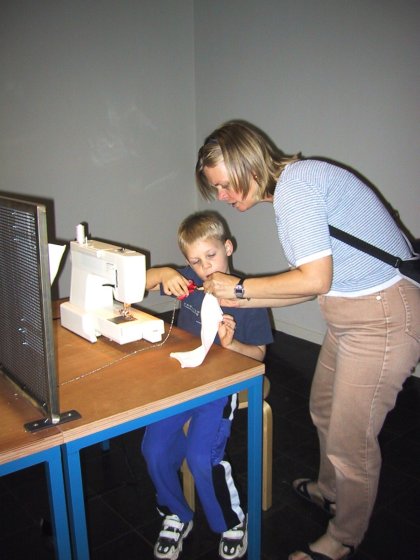David's Diary: Friday, September 1, 2001
Tilburg Textile Museum

Allen Making A Sack
Today was moving day as our time in our bungalow had run out. We decided not to have school today and visit the nearby town of Tilburg instead. One of the highlights of Tilburg is its textile museum. The area around Tilburg was a major center for textile production. Before the 1850s, most textiles were made at home. As the Industrial Revolution got underway textile manufacturing moved to factories driven by large steam engines, but home and factory manufacturing continued together for more than fifty years. Eventually all textile production moved to the factories and over time electric engines replaced steam as the means of power. Today the museum is all that is left of a once thriving industry as textile production has moved to other countries due to a variety of factors.
The museum currently has a hands-on display. To start, Jocelyn, Kevin, and Allen stopped at a series of workstations. They cut fabric, sewed it closed, stamped the outside, wrote their name on it, and created a tie for the top. There were also displays that demonstrated how a weaving machine worked and the staff were helpful showing us a hundred year-old weaving machine in operation.

Modern Knitting Machine
The museum has a historical section showing how a massive stream engine would drive a flywheel. This flywheel would then turn smaller driveshafts that ran the length of the factory. Individual weaving machines would then use a leather strap on a small flywheel connected to the driveshaft to power the individual machine. At full force the factory must have been incredibly noisy.
We also saw machines that turned raw wool into thread, giant rolls of thread, and weaving machines from many different eras. But the Tilburg Textile Museum is also a working museum. Another section contains working weaving and knitting machines that are used to create fabric for artists, designers, companies, or private individuals. We got to see many of these in operation and were even allowed to run some of them. We even watched the knitting machine that made the fabric that we used to create our sacks.